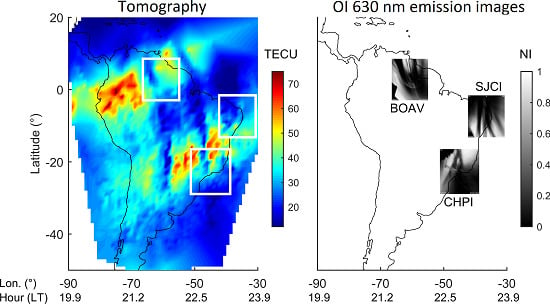Tomographic Imaging of Ionospheric Plasma Bubbles Based on GNSS and Radio Occultation Measurements
Abstract
1. Introduction
2. Ionospheric Tomography Method
2.1. Ionospheric Background
2.2. Regional Tomography
3. Horizontal Distribution of Plasma Bubbles
3.1. Feasibility of Mapping Plasma Bubbles by the Tomographic Reconstruction
3.2. Systematic Assessment
4. Vertical Distribution of Plasma Bubbles
5. Conclusions
Author Contributions
Funding
Acknowledgments
Conflicts of Interest
References
- Abdu, M.A. Equatorial ionosphere–thermosphere system: Electrodynamics and irregularities. Adv. Space Res. 2005, 35, 771–787. [Google Scholar] [CrossRef]
- Lee, C.-C.; Su, S.-Y.; Reinisch, B.W. Concurrent study of bottomside spread F and plasma bubble events in the equatorial ionosphere during solar maximum using digisonde and ROCSAT-1. Ann. Geophys. 2005, 23, 3473–3480. [Google Scholar] [CrossRef]
- Haase, J.S.; Dautermann, T.; Taylor, M.J.; Chapagain, N.; Calais, E.; Pautet, D. Propagation of plasma bubbles observed in Brazil from GPS and airglow data. Adv. Space Res. 2011, 47, 1758–1776. [Google Scholar] [CrossRef]
- Paznukhov, V.V.; Carrano, C.S.; Doherty, P.H.; Groves, K.M.; Caton, R.G.; Valladares, C.E.; Seemala, G.K.; Bridgwood, C.T.; Adeniyi, J.; Amaeshi, L.L.N.; et al. Equatorial plasma bubbles and L-band scintillations in Africa during solar minimum. Ann. Geophys. 2012, 30, 675–682. [Google Scholar] [CrossRef]
- Singh, S.; Bamgboye, D.K.; McClure, J.P.; Johnson, F.S. Morphology of equatorial plasma bubbles. J. Geophys. Res. 1997, 102, 20019–20029. [Google Scholar] [CrossRef]
- Burke, W.J.; Gentile, L.C.; Huang, C.Y.; Valladares, C.E.; Su, S.Y. Longitudinal variability of equatorial plasma bubbles observed by DMSP and ROCSAT-1. J. Geophys. Res. Space Phys. 2004, 109, A12301. [Google Scholar] [CrossRef]
- Nishioka, M.; Saito, A.; Tsugawa, T. Occurrence characteristics of plasma bubble derived from global ground-based GPS receiver networks. J. Geophys. Res. 2008, 113, A05301. [Google Scholar] [CrossRef]
- Patel, K.; Singh, A.K. Characteristic of plasma bubbles observed by DMSP in the topside ionosphere during the year 2005. J. Earth Syst. Sci. 2010, 119, 211–220. [Google Scholar] [CrossRef]
- Xiong, C.; Lühr, H.; Ma, S.Y.; Stolle, C.; Fejer, B.G. Features of highly structured equatorial plasma irregularities deduced from CHAMP observations. Ann. Geophys. 2012, 30, 1259–1269. [Google Scholar] [CrossRef]
- Rastogi, R.G. Seasonal variation of equatorial spread F in the American and Indian zones. J. Geophys. Res. 1980, 85, 722–726. [Google Scholar] [CrossRef]
- Saito, S.; Maruyama, T. Ionospheric height variations observed by ionosondes along magnetic meridian and plasma bubble onsets. Ann. Geophys. 2006, 24, 2991–2996. [Google Scholar] [CrossRef]
- Wang, G.J.; Shi, J.K.; Reinisch, B.W.; Wang, X.; Wang, Z. Ionospheric plasma bubbles observed concurrently by multi-instruments over low-latitude station Hainan. J. Geophys. Res. Space Phys. 2015, 120, 2288–2298. [Google Scholar] [CrossRef]
- Kelley, M.C.; Makela, J.J.; Paxton, L.J.; Kamalabadi, F.; Comberiate, J.M.; Kil, H. The first coordinated ground-based and space-based optical observations of equatorial plasma bubbles. Geophys. Res. Lett. 2003, 30, 1766. [Google Scholar] [CrossRef]
- Maruyama, T.; Matuura, N. Longitudinal variability of annual changes in activity of equatorial spread F and plasma bubbles. J. Geophys. Res. 1984, 89, 10903–10912. [Google Scholar] [CrossRef]
- Huang, C.-S.; La Beaujardiere, O.; Roddy, P.A.; Hunton, D.E.; Liu, J.Y.; Chen, S.P. Occurrence probability and amplitude of equatorial ionospheric irregularities associated with plasma bubbles during low and moderate solar activities (2008–2012). J. Geophys. Res. Space Phys. 2014, 119, 1186–1199. [Google Scholar] [CrossRef]
- Huang, C.Y.; Burke, W.J.; Machuzak, J.S.; Gentile, L.C.; Sultan, P. DMSP observations of equatorial plasma bubbles in the topside ionosphere near solar maximum. J. Geophys. Res. 2001, 106, 8131–8142. [Google Scholar] [CrossRef]
- Dyson, P.L.; Benson, R.F. Topside sounder observations of equatorial bubbles. Geophys. Res. Lett. 1978, 5, 795–798. [Google Scholar] [CrossRef]
- Kumar, S. Morphology of equatorial plasma bubbles during low and high solar activity years over Indian sector. Astrophys. Space Sci. 2017, 362, 93. [Google Scholar] [CrossRef]
- Li, G.; Ning, B.; Zhao, B.; Liu, L.; Wan, W.; Ding, F.; Xu, J.S.; Liu, J.Y.; Yumoto, K. Characterizing the 10 November 2004 storm-time middle-latitude plasma bubble event in Southeast Asia using multi-instrument observations. J. Geophys. Res. 2009, 114, A07304. [Google Scholar] [CrossRef]
- Zakharenkova, I.; Astafyeva, E. Topside ionospheric irregularities as seen from multisatellite observations. J. Geophys. Res. Space Phys. 2015, 120, 807–824. [Google Scholar] [CrossRef]
- Park, J.; Min, K.W.; Lee, J.-J.; Kil, H.; Kim, V.P.; Kim, H.-J.; Lee, E.; Lee, D.Y. Plasma blob events observed by KOMPSAT-1 and DMSP F15 in the low latitude nighttime upper ionosphere. Geophys. Res. Lett. 2003, 30, 2114. [Google Scholar] [CrossRef]
- Basu, S.; Basu, S. Equatorial scintillations: Advances since ISEA-6. J. Atmos. Terr. Phys. 1985, 47, 753–768. [Google Scholar] [CrossRef]
- Aarons, J. The longitudinal morphology of equatorial F-layer irregularities relevant to their occurrence. Space Sci. Rev. 1993, 63, 209–243. [Google Scholar] [CrossRef]
- McNamara, L.F.; Caton, R.G.; Parris, R.T.; Pedersen, T.R.; Thompson, D.C.; Wiens, K.C.; Groves, K.M. Signatures of equatorial plasma bubbles in VHF satellite scintillations and equatorial ionograms. Radio Sci. 2013, 48, 89–101. [Google Scholar] [CrossRef]
- Rezende, L.F.C.; de Paula, E.R.; Kantor, I.J.; Kintner, P.M. Mapping and Survey of Plasma Bubbles over Brazilian Territory. J. Navig. 2007, 60, 69–81. [Google Scholar] [CrossRef]
- Muella, M.T.A.H.; Duarte-Silva, M.H.; Moraes, A.O.; de Paula, E.R.; Rezende, L.F.C.; Alfonsi, L.; Affonso, B.J. Climatology and modeling of ionospheric scintillations and irregularity zonal drifts at the equatorial anomaly crest region. Ann. Geophys. 2017, 35, 1201–1218. [Google Scholar] [CrossRef]
- Shiokawa, K.; Otsuka, Y.; Lynn, K.J.W.; Wilkinson, P.; Tsugawa, T. Airglow-imaging observation of plasma bubble disappearance at geomagnetically conjugate points. Earth Planets Space 2015, 67, 43. [Google Scholar] [CrossRef]
- Sobral, J.H.A.; Abdu, M.A.; Takahashi, H.; Taylor, M.J.; de Paula, E.R.; Zamlutti, C.J.; Aquino, M.G.; Borba, G.L. Ionospheric plasma bubble climatology over Brazil based on 22 years (1977–1998) of airglow observations. J. Atmos. Sol. Terr. Phys. 2002, 64, 1517–1524. [Google Scholar] [CrossRef]
- Fukushima, D.; Shiokawa, K.; Otsuka, Y.; Nishioka, M.; Kubota, M.; Tsugawa, T.; Nagatsuma, T.; Komonjinda, S.; Yatini, C.Y. Geomagnetically conjugate observation of plasma bubbles and thermospheric neutral winds at low latitudes. J. Geophys. Res. Space Phys. 2015, 120, 2222–2231. [Google Scholar] [CrossRef]
- Ogawa, T.; Sagawa, E.; Otsuka, Y.; Shiokawa, K.; Immel, T.I.; Mende, S.B.; Wilkinson, P. Simultaneous ground- and satellite-based airglow observations of geomagnetic conjugate plasma bubbles in the equatorial anomaly. Earth Planets Space 2005, 57, 385–392. [Google Scholar] [CrossRef]
- Takahashi, H.; Wrasse, C.M.; Otsuka, Y.; Ivo, A.; Gomes, V.; Paulino, I.; Medeiros, A.F.; Denardini, C.M.; Sant’anna, N.; Shiokawa, K. Plasma bubble monitoring by TEC map and 630 nm airglow image. J. Atmos. Sol. Terr. Phys. 2015, 130, 151–158. [Google Scholar] [CrossRef]
- Takahashi, H.; Wrasse, C.M.; Denardini, C.M.; Pádua, M.B.; de Paula, E.R.; Costa, S.M.A.; Otsuka, Y.; Shiokawa, K.; Monico, J.F.G.; Ivo, A.; et al. Ionospheric TEC Weather Map Over South America. Space Weather 2016, 14, 937–949. [Google Scholar] [CrossRef]
- Bust, G.S.; Mitchell, C.N. History, current state, and future directions of ionospheric imaging. Rev. Geophys. 2008, 46, RG1003. [Google Scholar] [CrossRef]
- Retterer, J.M.; Roddy, P. Faith in a seed: On the origins of equatorial plasma bubbles. Ann. Geophys. 2014, 32, 485–498. [Google Scholar] [CrossRef]
- Prol, F.S.; Camargo, P.O. Ionospheric tomography using GNSS: Multiplicative algebraic reconstruction technique applied to the area of Brazil. GPS Solut. 2016, 20, 807–814. [Google Scholar] [CrossRef]
- Moraes, A.O.; Vani, B.C.; Costa, E.; Abdu, M.A.; de Paula, E.R.; Sousasantos, J.; Monico, J.F.G.; Forte, B.; Negreti, P.M.S.; Shimabukuro, M.H. GPS availability and positioning issues when the signal paths are aligned with ionospheric plasma bubbles. GPS Solut. 2018, 22, 95. [Google Scholar] [CrossRef]
- Prol, F.S.; Hernández-Pajares, M.; Camargo, P.O.; Muella, M.T.A.H. Spatial and temporal features of the topside ionospheric electron density by a new model based on GPS radio occultation data. J. Geophys. Res. Space Phys. 2018, 123, 2104–2115. [Google Scholar] [CrossRef]
- Jin, S.; Li, D. 3-D ionospheric tomography from dense GNSS observations based on an improved two-step iterative algorithm. Adv. Space Res. 2018, 62, 809–820. [Google Scholar] [CrossRef]
- Prol, F.S.; Camargo, P.O.; Monico, J.F.G.; Muella, M.T.A.H. Assessment of a TEC calibration procedure by single-frequency PPP. GPS Solut. 2018, 22, 35. [Google Scholar] [CrossRef]
- Pimenta, A.A.; Sahai, Y.; Bittencourt, J.A.; Rich, F.J. Ionospheric plasma blobs observed by OI 630 nm all-sky imaging in the Brazilian tropical sector during the major geomagnetic storm of April 6–7, 2000. Geophys. Res. Lett. 2007, 34, L02820. [Google Scholar] [CrossRef]
- Makela, J.J.; Kelley, M.C. Field-aligned 777.4-nm composite airglow images of equatorial plasma depletions. Geophys. Res. Lett. 2003, 30, 1442. [Google Scholar] [CrossRef]
- Barros, D.; Takahashi, H.; Wrasse, C.M.; Figueiredo, C.A.O.B. Characteristics of equatorial plasma bubbles observed by TEC map based on ground-based GNSS receivers over South America. Ann. Geophys. 2018, 36, 91–100. [Google Scholar] [CrossRef]
- Kunitsyn, V.E.; Andreeva, E.S.; Tereshchenko, E.D.; Khudukon, B.Z.; Nygren, T. Investigations of the ionosphere by satellite radiotomography. Int. J. Imaging Syst. Technol. 1994, 5, 112–127. [Google Scholar] [CrossRef]
- Prol, F.S.; Camargo, P.O.; Muella, M.T.A.H. Numerical Simulations to Assess ART and MART Performance for Ionospheric Tomography of Chapman Profiles. Anais da Academia Brasileira de Ciências 2017, 89, 1531–1542. [Google Scholar] [CrossRef] [PubMed]
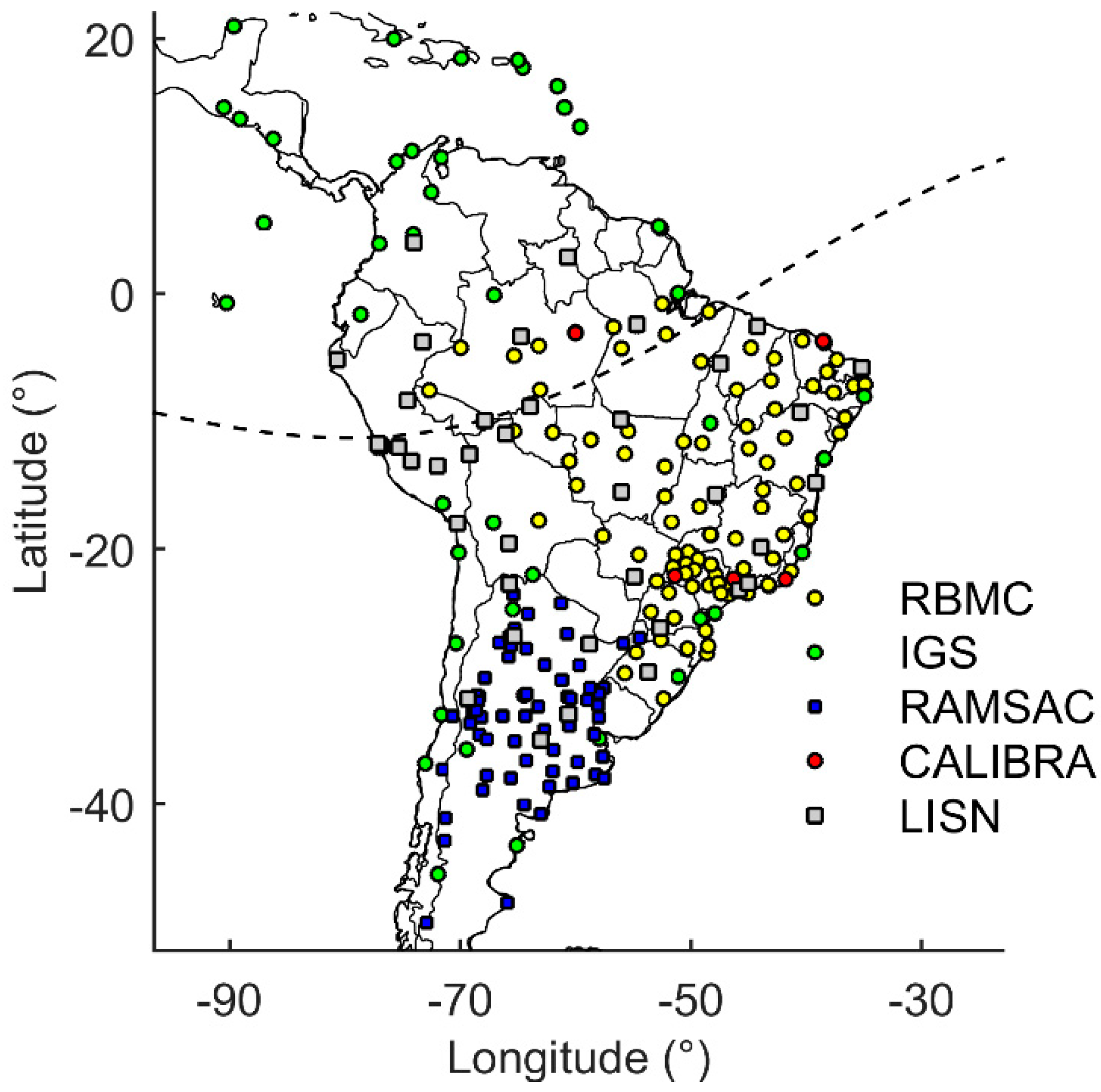
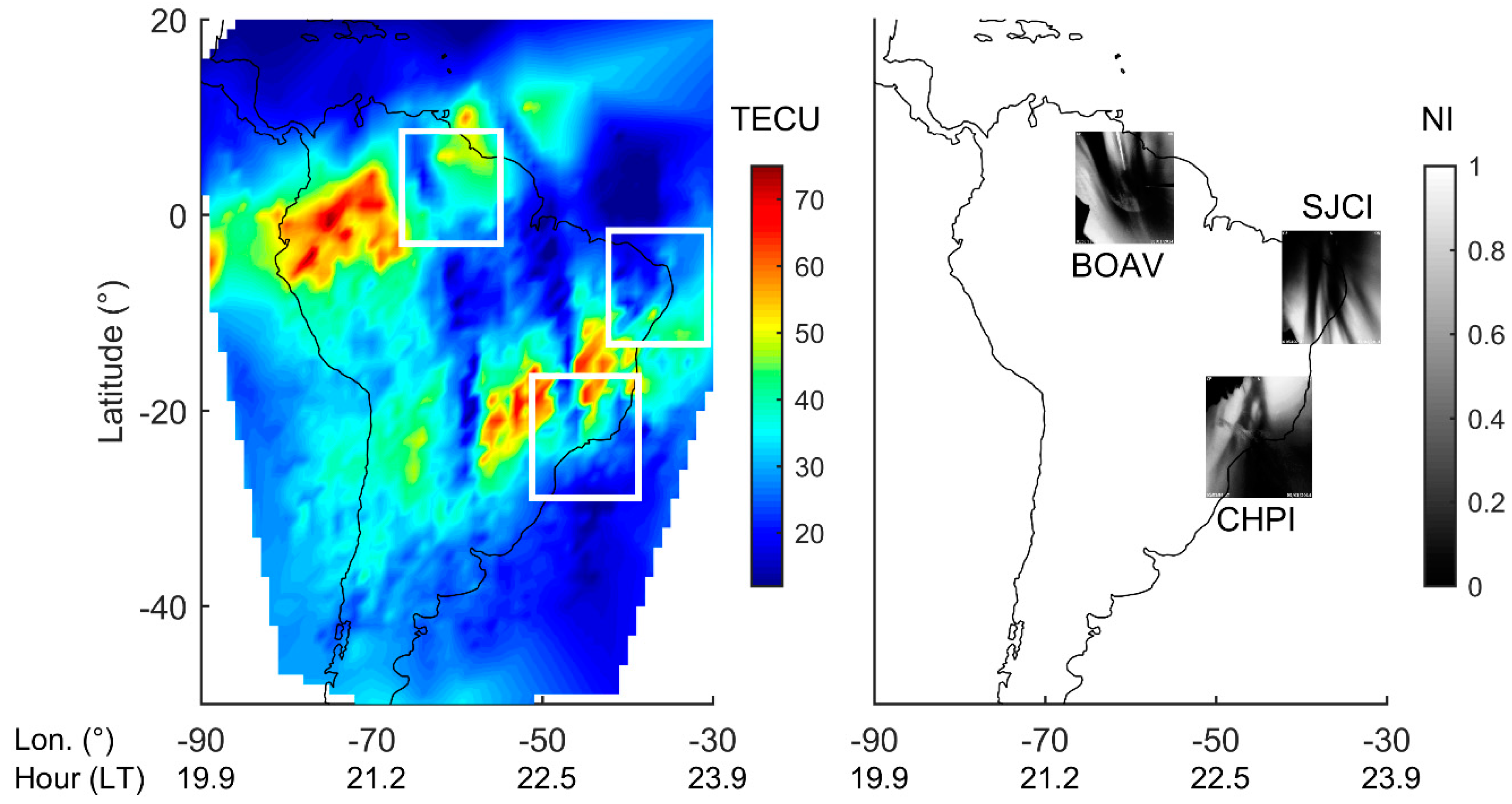
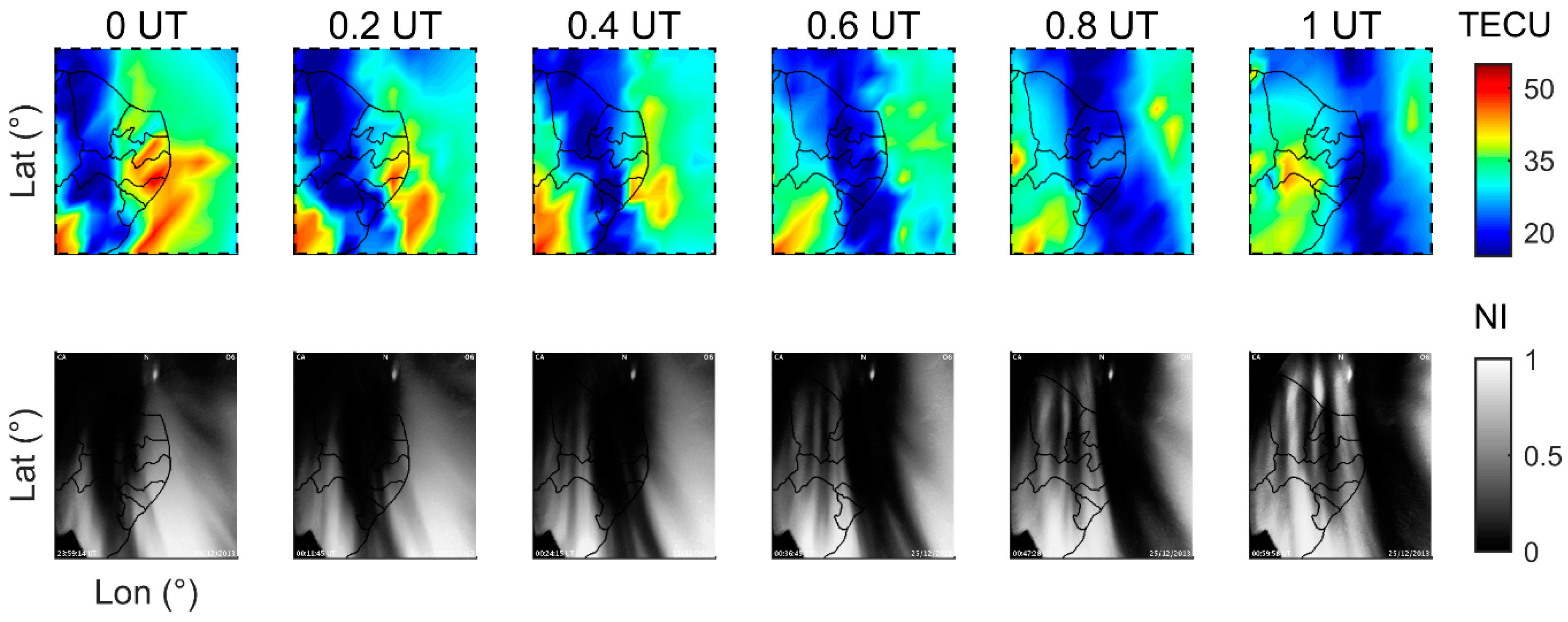
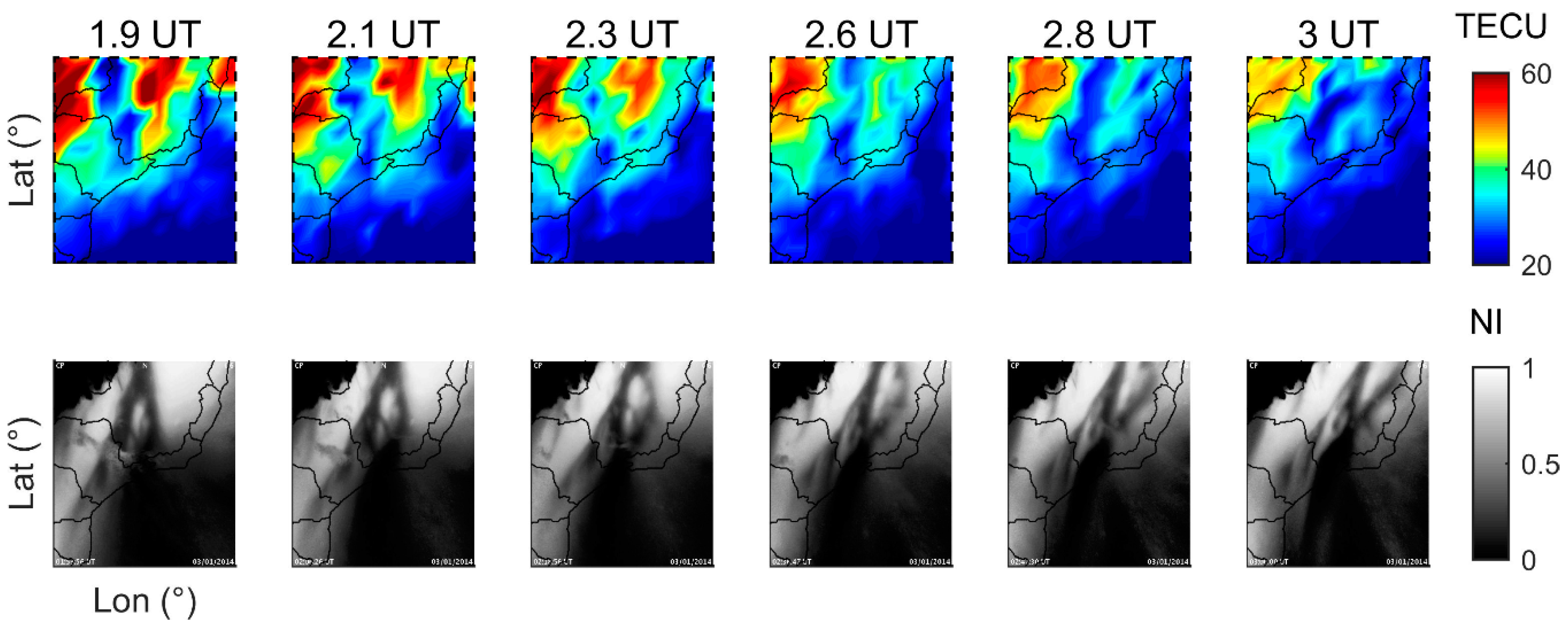
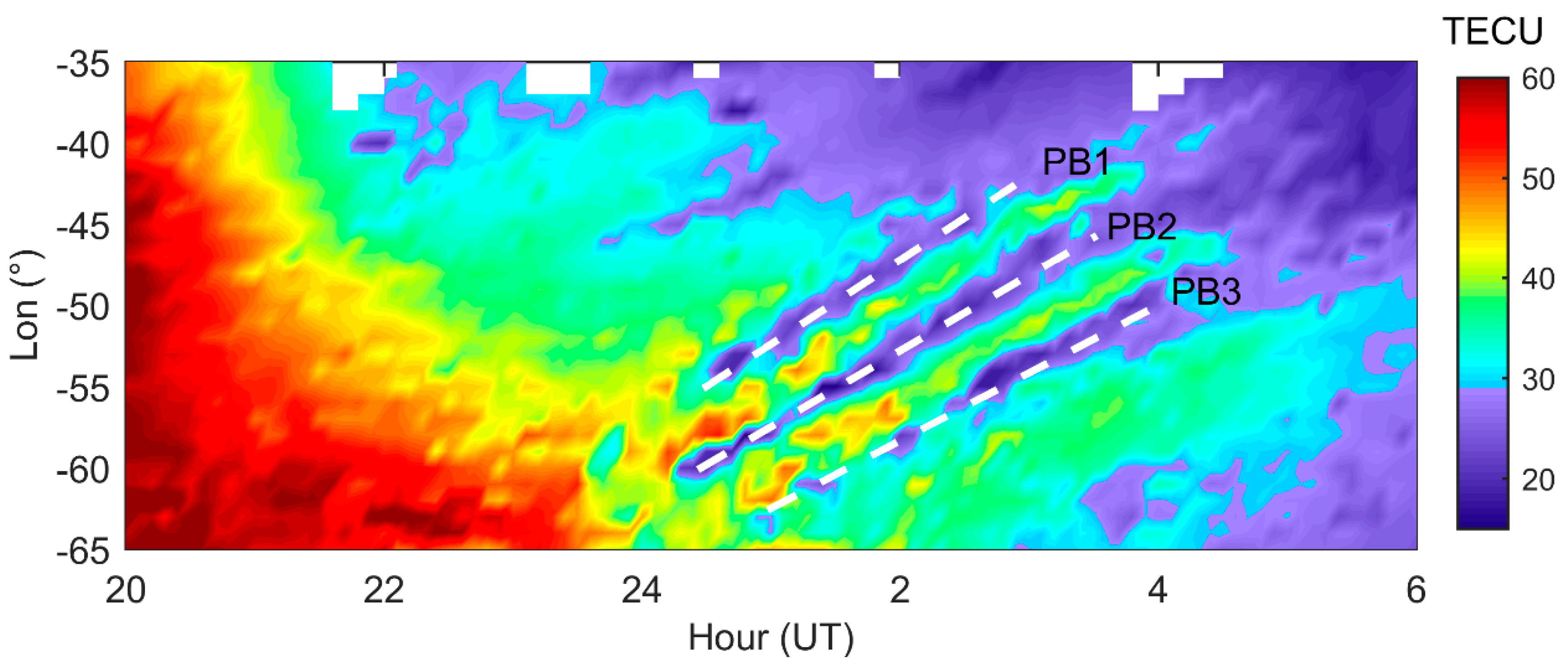

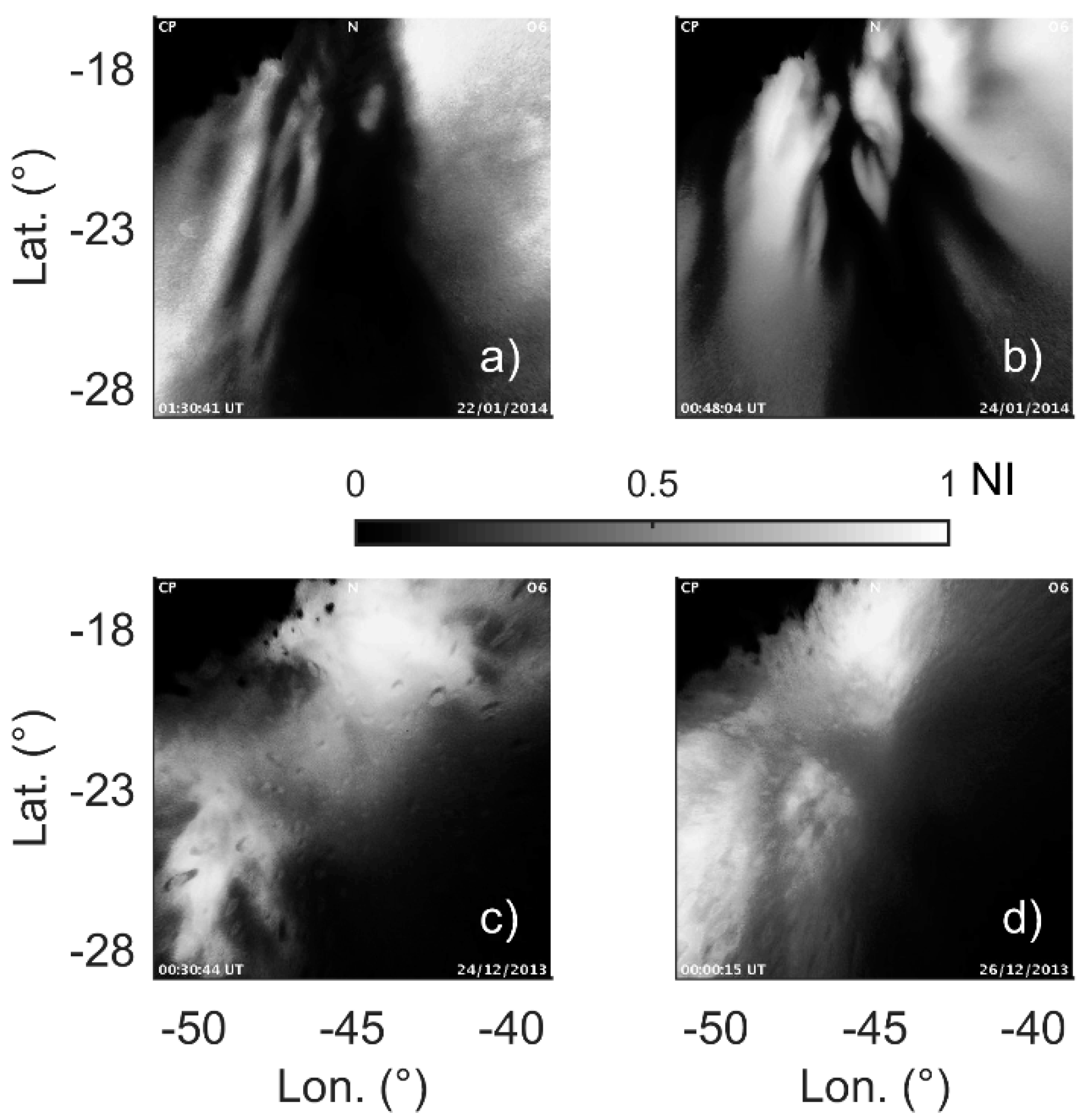
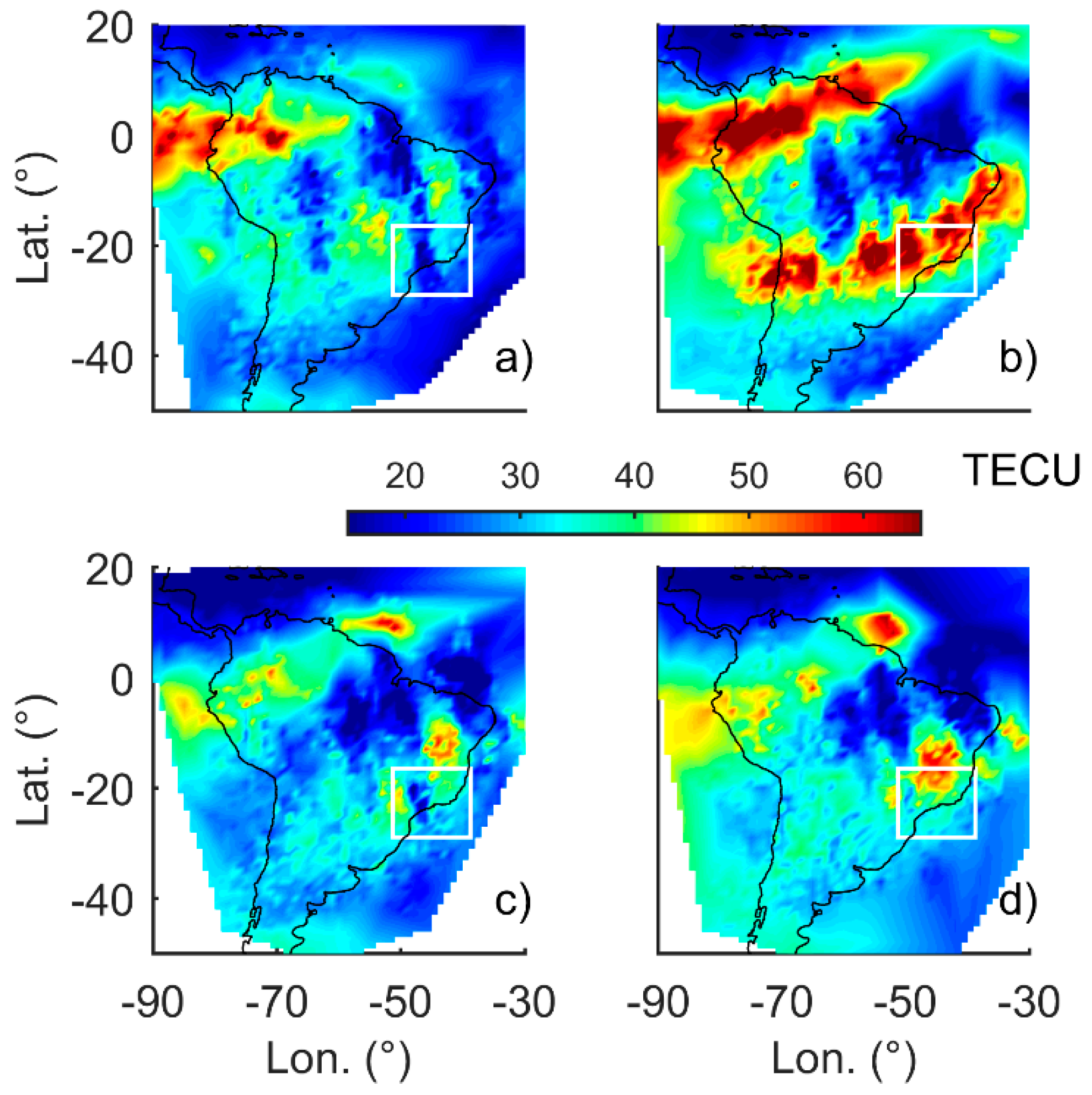
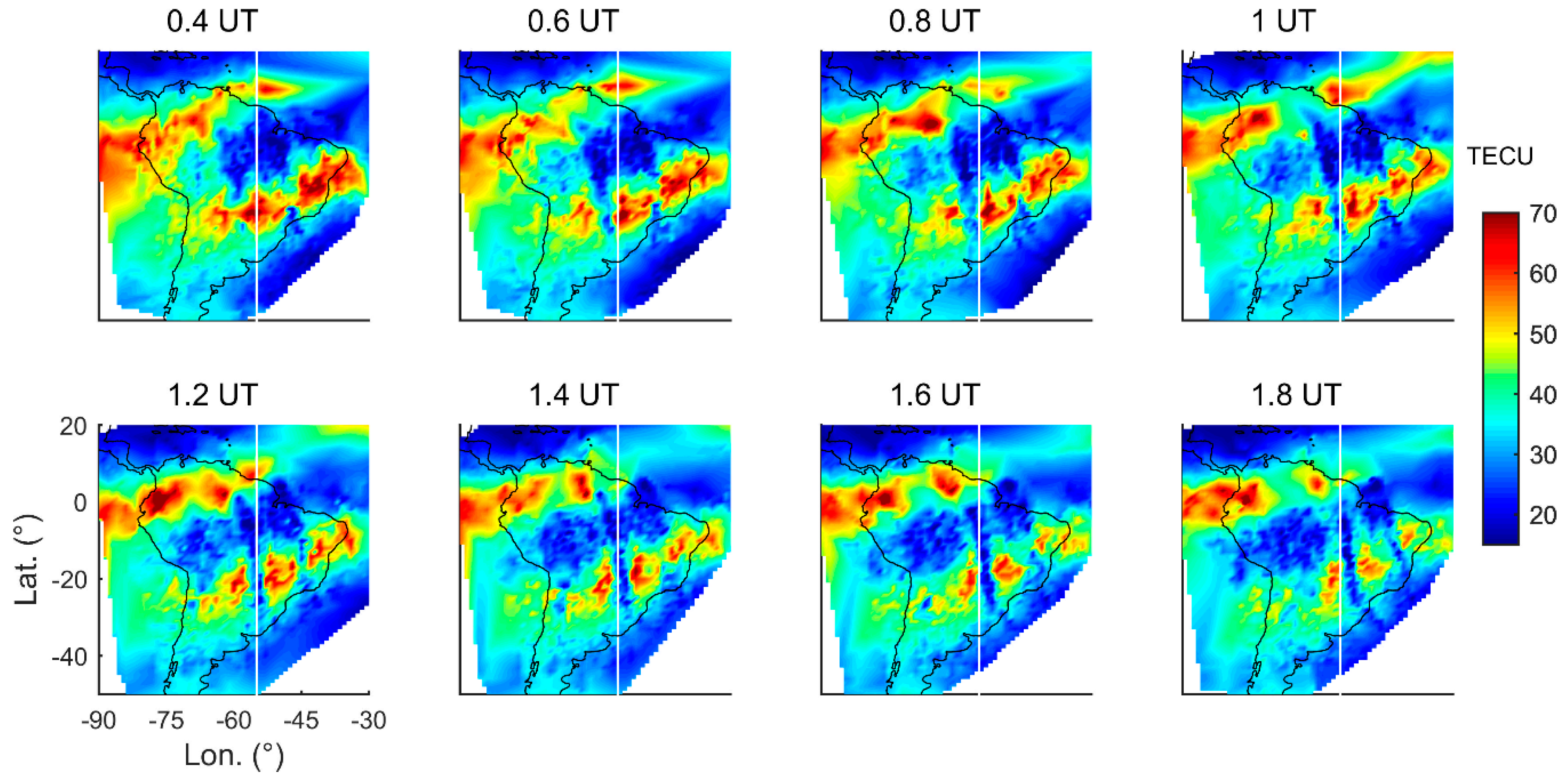
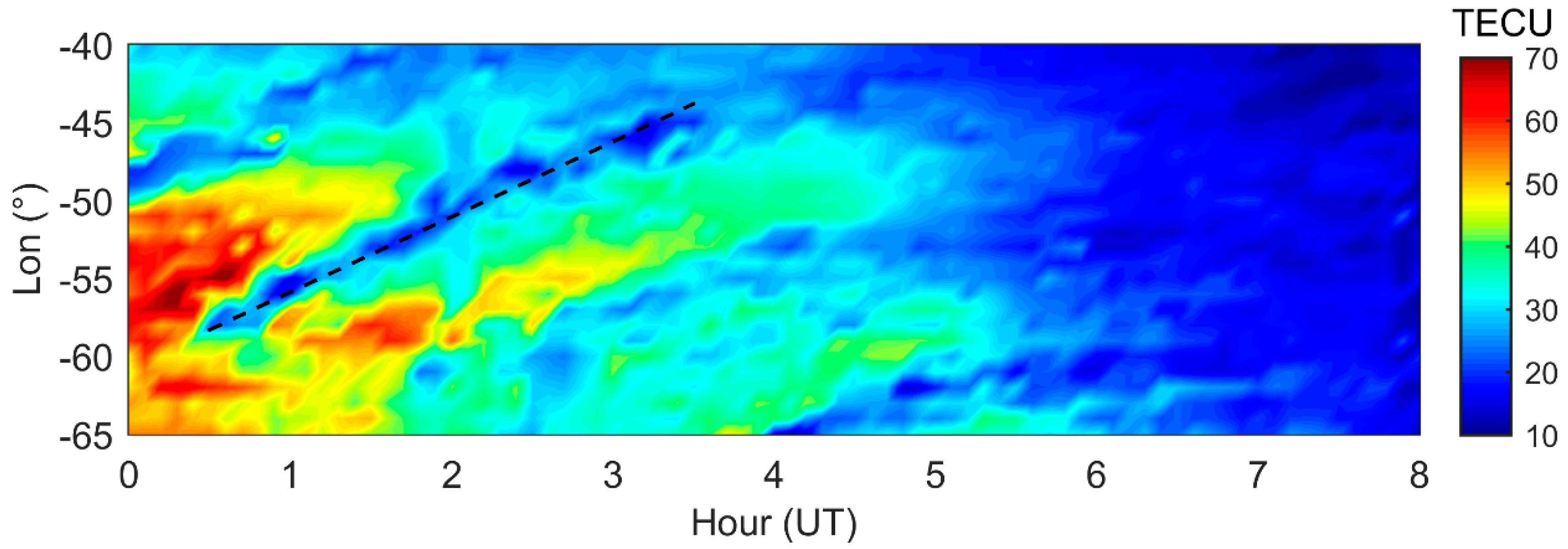
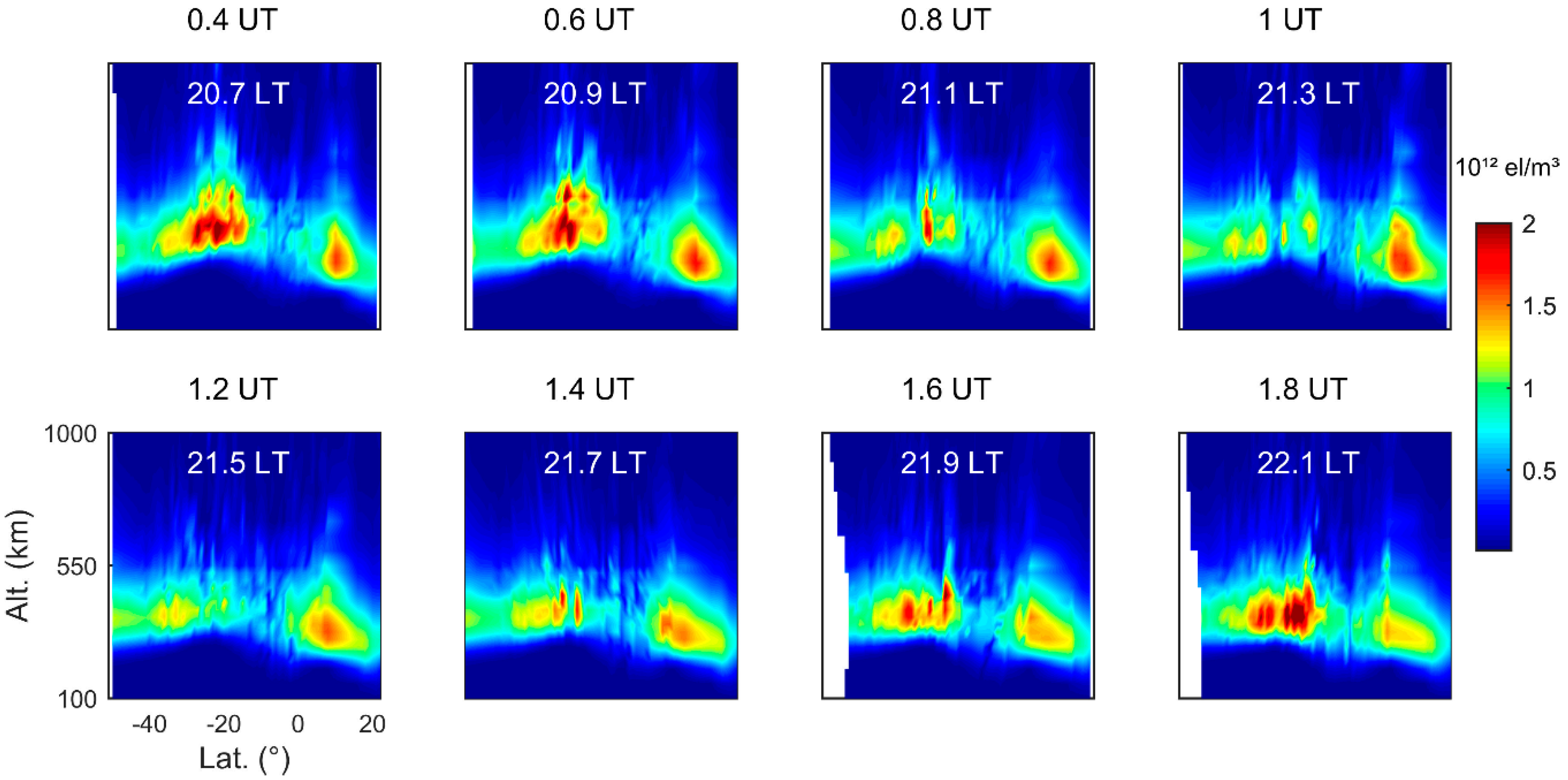
| Tomography | ||||
|---|---|---|---|---|
| With Bubbles | Uncertain | Without Bubbles | ||
| Airglow | With Bubbles | 181 (29%) | 36 (5.9%) | 117 (19%) |
| Uncertain | 6 (0.9%) | 34 (5.6%) | 80 (13%) | |
| Without Bubbles | 21 (3.4%) | 0 (0%) | 135 (22%) | |
| Tomography | ||||
|---|---|---|---|---|
| With Bubbles | Uncertain | Without Bubbles | ||
| Airglow | With Bubbles | 133 (18%) | 102 (14%) | 187 (26%) |
| Uncertain | 5 (0.7%) | 28 (3.9%) | 29 (4.1%) | |
| Without Bubbles | 21 (2.9%) | 0 (0%) | 204 (29%) | |
| Tomography | ||||
|---|---|---|---|---|
| With Bubbles | Uncertain | Without Bubbles | ||
| Airglow | With Bubbles | 108 (15%) | 71 (9.6%) | 242 (33%) |
| Uncertain | 0 (0%) | 23 (3.1%) | 33 (4.5%) | |
| Without Bubbles | 51 (6.9%) | 32 (4.3%) | 179 (24%) | |
© 2018 by the authors. Licensee MDPI, Basel, Switzerland. This article is an open access article distributed under the terms and conditions of the Creative Commons Attribution (CC BY) license (http://creativecommons.org/licenses/by/4.0/).
Share and Cite
Dos Santos Prol, F.; Hernández-Pajares, M.; Tadeu de Assis Honorato Muella, M.; De Oliveira Camargo, P. Tomographic Imaging of Ionospheric Plasma Bubbles Based on GNSS and Radio Occultation Measurements. Remote Sens. 2018, 10, 1529. https://doi.org/10.3390/rs10101529
Dos Santos Prol F, Hernández-Pajares M, Tadeu de Assis Honorato Muella M, De Oliveira Camargo P. Tomographic Imaging of Ionospheric Plasma Bubbles Based on GNSS and Radio Occultation Measurements. Remote Sensing. 2018; 10(10):1529. https://doi.org/10.3390/rs10101529
Chicago/Turabian StyleDos Santos Prol, Fabricio, Manuel Hernández-Pajares, Marcio Tadeu de Assis Honorato Muella, and Paulo De Oliveira Camargo. 2018. "Tomographic Imaging of Ionospheric Plasma Bubbles Based on GNSS and Radio Occultation Measurements" Remote Sensing 10, no. 10: 1529. https://doi.org/10.3390/rs10101529
APA StyleDos Santos Prol, F., Hernández-Pajares, M., Tadeu de Assis Honorato Muella, M., & De Oliveira Camargo, P. (2018). Tomographic Imaging of Ionospheric Plasma Bubbles Based on GNSS and Radio Occultation Measurements. Remote Sensing, 10(10), 1529. https://doi.org/10.3390/rs10101529




